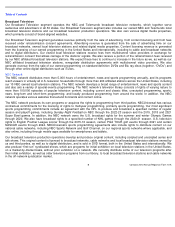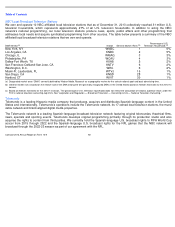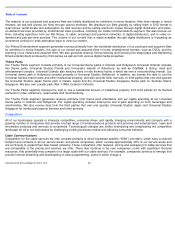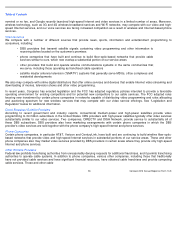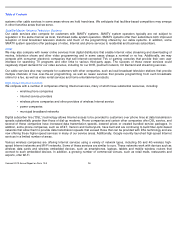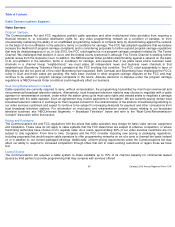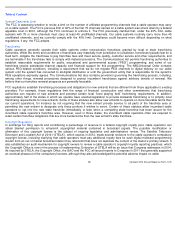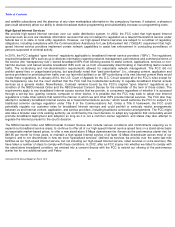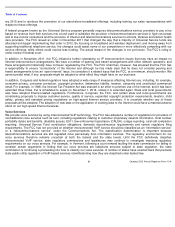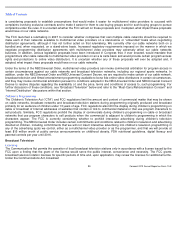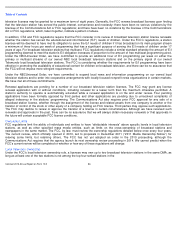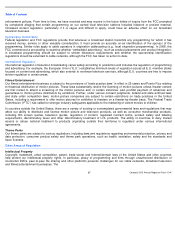Comcast 2013 Annual Report Download - page 24
Download and view the complete annual report
Please find page 24 of the 2013 Comcast annual report below. You can navigate through the pages in the report by either clicking on the pages listed below, or by using the keyword search tool below to find specific information within the annual report.
Table of Contents
Vertical Ownership Limit
The FCC is assessing whether to revise a limit on the number of affiliated programming channels that a cable operator may carry
on a cable system. The FCC’
s previous limit of 40% of the first 75 channels carried on a cable system was struck down by a federal
appellate court in 2001, although the FCC continues to enforce it. The FCC previously clarified that, under the 40% limit, cable
systems with 75 or more channels must carry at least 45 unaffiliated channels. Our cable systems routinely carry more than 45
unaffiliated channels, and we currently comply with the 40% limit. Compliance could become more difficult depending on what
regulations, if any, the FCC adopts.
Franchising
Cable operators generally operate their cable systems under nonexclusive franchises granted by local or state franchising
authorities. While the terms and conditions of franchises vary materially from jurisdiction to jurisdiction, franchises typically last for a
fixed term, obligate the franchisee to pay franchise fees and meet service quality, customer service and other requirements, and
are terminable if the franchisee fails to comply with material provisions. The Communications Act permits franchising authorities to
establish reasonable requirements for public, educational and governmental access (“PEG”)
programming, and some of our
franchises require substantial channel capacity and financial support for this programming. The NBCUniversal Order contains
various PEG-
related conditions, including a requirement that we do not migrate PEG channels to digital delivery on our cable
system until the system has converted to all-digital distribution or until the government entity that is responsible for the system’
s
PEG operations expressly agrees. The Communications Act also contains provisions governing the franchising process, including,
among other things, renewal procedures designed to protect incumbent franchisees against arbitrary denials of renewal. We
believe that our franchise renewal prospects are generally favorable.
FCC regulations establish franchising processes and obligations for new entrants that are different from those applicable to existing
providers. For example, these regulations limit the range of financial, construction and other commitments that franchising
authorities can request of new entrants and preempt certain local “level playing field”
franchising requirements. In addition,
approximately half of the states in which we operate have enacted legislation to provide statewide franchising or to simplify local
franchising requirements for new entrants. Some of these statutes also allow new entrants to operate on more favorable terms than
our current operations, for instance by not requiring that the new entrant provide service to all parts of the franchise area or
permitting the new entrant to designate only those portions it wishes to serve. Certain of these statutes allow incumbent cable
operators to opt into the new state franchise immediately or later when a competing state franchise has been issued for the
incumbent cable operator’
s franchise area. However, even in those states, the incumbent cable operators often are required to
retain certain franchise obligations that are more burdensome than the new entrant’s state franchise.
Copyright Regulation
In exchange for filing reports and contributing a percentage of revenue to a federal copyright royalty pool, cable operators can
obtain blanket permission to retransmit copyrighted material contained in broadcast signals. The possible modification or
elimination of this copyright license is the subject of ongoing legislative and administrative review. The Satellite Television
Extension and Localism Act of 2010 (“STELA”), which expires in 2014, made several revisions to the cable operator’
s compulsory
copyright license, including clarifying that cable operators must pay additional royalty fees for each digital multicast programming
stream from an out-of market broadcast station they retransmit that does not duplicate the content of the station’
s primary stream. It
also establishes an audit mechanism for copyright owners to review a cable operator’
s copyright royalty reporting practices, which
the Copyright Office is now in the process of implementing. Extension of STELA will be an issue that Congress addresses in 2014.
As required by STELA, the Copyright Office, the GAO and the FCC all issued reports to Congress in 2011 that generally supported
an eventual phaseout of the compulsory licenses, although they also acknowledged the potential adverse impact on cable
19
Comcast 2013 Annual Report on Form 10
-
K


